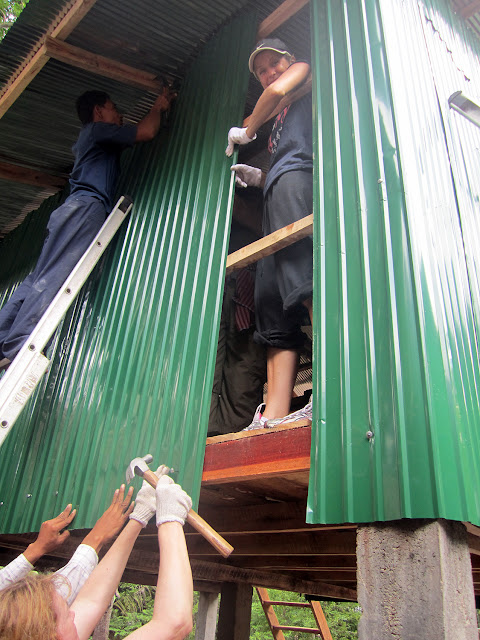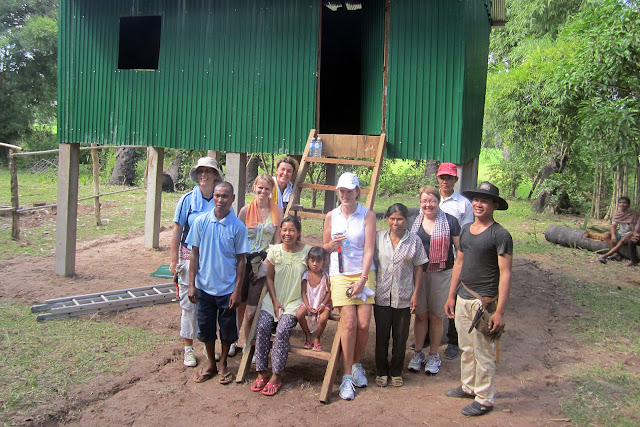The idea of a trip to Cambodia
was first mooted in June by Deirdre, later to be renamed Dolly’s Tours*. By mid
September the original 17 volunteers had whittled down to 10 and set off on 8th
October to Phnom Penh. Most of us had children who were still at, or had
recently graduated from, Tanglin and who had done a similar school trip at the
end of year 11.
I flew from KL and met the others
at the airport. We headed straight to Tabitha for a briefing on what to expect
the following day. Janne Ritskes, originally from Canada and now the only “western”
Cambodian citizen, is co founder of the organisation. Tabitha has many arms but
their work includes house building, wells, cottage industries and schools. At
the moment they are fundraising for a hospital to open in 2014. See www.tabitha-cambodia.org for more
information.
Janne gave us a very
comprehensive history of Cambodia before she laid down the rules for house
building. She made it clear that this activity was not about us, it was for the
local families. We therefore had to remain cheerful at all times, especially if
we had just smashed our finger with a hammer. If we found the locals staring at
us it was probably because we had drawn blood and we had to cover it
immediately with a plaster. It was absolutely forbidden to hold a baby as it
was probably being offered in payment for their new house and the family would
not take it back. We were not allowed to complement a child as the parents
would think we wanted to steal it. By the time we left for lunch, most of us
wondered what we were letting ourselves in for.
The afternoon was spent visiting
S21, a former school which was later used as a prison during the Pol Pot
regime. Only 7 people survived S21 and that was because they had skills
required by their torturers. Some of the paintings and photographs we saw were
done by these survivors. We then went to
the Killing Fields, about 15 km from the city. A beautiful memorial has been
built to house the skulls of the victims whose mass graves have been unearthed.
Signs around the vicinity left nothing to the imagination, including the tree
against which babies were beaten to death. We were a very quiet group on our
way back to the hotel.
 |
| Memorial at the Killing Fields |
 |
| Killing Fields notice |
 |
| A cell in the notorious S21 |
 |
| With Bou Meng, one of the few survivors |
We had dinner at the Foreign
Correspondents Club which has added another floor since I was last there 6
years ago. The riverside has also been paved and was well used by local people
exercising. Phnom Penh generally is booming as evidenced by the number of banks
and the amount of new construction. My only concern was the Oxfam building
which could have easily been the country HQ for an international bank; evidence
that some charities are spending too much money on administration.
On Tuesday morning we set off
early for a 2 hour drive into the countryside north of the city. We had a
longer than usual journey in order to avoid a new bridge being officially
opened by the prime minister. On arrival we were met by a curious group of
locals whom we greeted in Khmer as instructed by Janne the previous day. We
then divided into two teams and set to work.
I understand that the local
families pay US$25 and the volunteers pay US$980. Our contribution was funded
by Tanglin from excess funds raised by us in past charity auctions. Tabitha has
a team of builders who start the work. They built the concrete pillars and had
the frames, including the floorboards, in place when we arrived. The roof had
also been completed. Our job was to nail down the floor boards and complete the
walls, of metal sheeting to be attached to the frame. The family could decide
how many windows they wanted and their location. Basically all we needed to do
was use a hammer, which we brought with us and donated to the family when we
left. The first house took a while as we were figuring out what we were doing.
We worked on and completed the second house by lunch time.
 |
| Nailing on the walls |
 |
| The building team. The house was assigned to the man in the blue shirt with his wife and daughter. |
After lunch I changed teams to
even up the numbers and this house seemed so much harder. We were blaming the
wood but we were probably getting tired and sore after stopping for a rest. The
husbands of the families all worked hard to finish their house and they were
extremely grateful to us by the end of the day.
We were expressly forbidden to
give any money or clothes to the villagers but we were allowed to leave all our
empty plastic water bottles behind. In a ceremony at the end of the day, we
presented blankets to each family-a gift from Tabitha. I got the impression
that the families couldn’t wait for us to leave so they could move in to their
new houses.
We had a much quicker trip back
and so had time to have drinks at the Elephant Bar at Raffles Hotel before
going to dinner at Le Rit’s. We later learned that Raffles Hotel had been used
as a hospital by the Khmer Rouge and that dead bodies were dumped in the
swimming pool. Le Rit’s is a boutique hotel, restaurant, shop run by an NGO to
support vulnerable women and children. It is not normally open for dinner but
the prospect of dinner for 11 people was too good to turn down. We were the
only people in the shop/restaurant and the two girls made and served a set
dinner with two choices of starters, main course and deserts very efficiently.
Wednesday morning saw us heading
off to Kais Kids, an orphanage that has been supported by Tanglin for the last
7 years. I visited it 6 years ago and was impressed with the improvements in
that time.
 |
| Making quilts at 'Tabitha' |
 |
| The local sewing team at 'Tabitha' |
We spent the morning painting a
room that will be used as a library and computer room by the older children.
After lunch some of us played with the younger children while the others did
cooking with the older children, aged from about 6 -12. They made spaghetti
bolognese, omelette and spring rolls. Karen, one of the directors encouraged
the older girls to write down the recipes and then translate them into Khmer.
One of the childrens’ nannies also took great interest in the cooking
demonstration.
As we were leaving the oldest
children were coming back from school. One was Lat who I had met when I was
there before. His older brother has since left the orphanage and is now a
steelworker. Cambodian law does not allow children over 7 years old to be
adopted. Lat and Hoo’s grandmother was still alive and would not give
permission for the boys to be adopted. That was such a pity as those boys could
have had a very different life. Lat came on the bus and fielded questions from
complete strangers in a foreign language-I doubt if Nikki or Dani would have
done the same at 16.
On the way back to Phnom Penh we got caught up in a horrendous traffic jam. Various explanations included a local factory holiday and a hungry ghost festival. One of our group had paid US$80 to get a taxi back from Kais earlier as she had to return to Singapore on Wednesday to attend a funeral. She had to walk the last half kilometer to the airport and just got there on time for her flight.
 |
| Part of a busy intersection. There is a traffic policeman there somewhere. |
We ended up going straight to dinner, still splattered with paint. We went to 'Friends' which is a training restaurant for street kids, also run by an NGO. This was probably the best meal we had and served with such enthusiasm despite our appearance. We left with a collection of their cook books and I have been creating Cambodian food since I got home.
Our last day was free for shopping. We went back to Tabitha and had a chance to share our house building experience with Janne as well as time to select a variety of souvenirs in Cambodian silk or silver.. Here I met a friend from Singapore who was part of the house building group from British Telecom, her husband's employer in Singapore. That was a really nice surprise.
Later we went to the Russian Market and after lunch at another training restaurant, not nearly as good as 'Friends', we headed for the conventional sops and a spa. On our last night we went back to FCC for drinks and we bumped into Susan and her 40+ BT colleagues. We finished up at Surin where we had lunch at the same place when we first arrived.
 |
| Local produce at the Russian market |
It was an early night for the 5am start the following morning. After all the traffic jams we wanted to have plenty of time to get to the airport----which we reached in 20 minutes. I was back in Penang via KL by 3.30pm. It was a fantastic trip, hard work but extremely rewarding.
* Deirdre has lived in Singapore since 1990. When booking a restaurant she always had to spell her name. After a while, sick of saying 'D for Dolly' she decided to call herself Dolly when making a reservation. Her organization throughout the trip was impeccable, from arranging packed lunches for everyone at Kais and house-building....to gin and tonics in the bus back, complete with ice, lemon and cucumber. We therefore decided that she deserved the title 'Dolly's Tours' and are having a flag made that she can use in the future.
 |
| 'Dolly' in the centre of sorting donated clothes. |
Helen Guy, October 2012






























